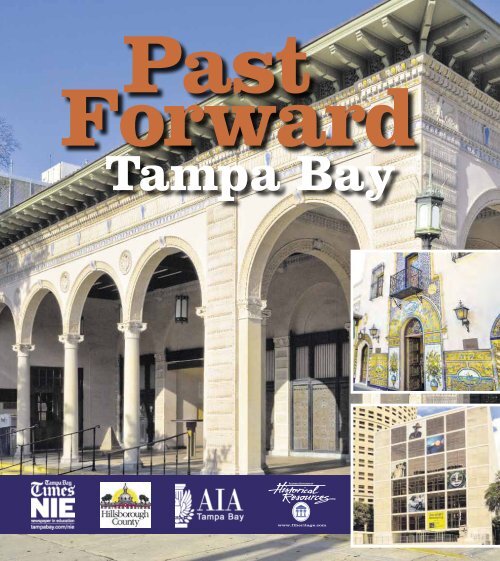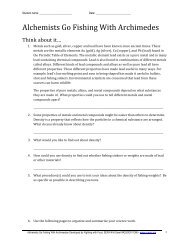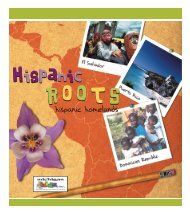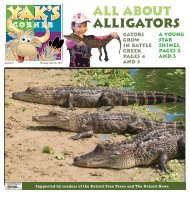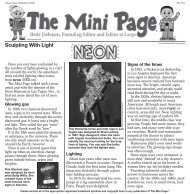Past Forward - Newspapers In Education
Past Forward - Newspapers In Education
Past Forward - Newspapers In Education
- No tags were found...
You also want an ePaper? Increase the reach of your titles
YUMPU automatically turns print PDFs into web optimized ePapers that Google loves.
KorrekturDrucksache 18/2265 – 2 – Deutscher Bundestag – 18. WahlperiodeK:\Publishing\Produktion\BT\Produktion\07_Fahne\1802265\1802265.fm, 8. August 2014, Seite 21. Sieht die Bundesregierung Änderungsbedarf an der nach den §§ 146, 147GVG bestehenden Weisungsgebundenheit des Generalbundesanwalts gegenüberdem Bundesminister der Justiz und für Verbraucherschutz?Wenn ja, will sie dieses Weisungsrecht abschaffen?Wenn nein, warum nicht?Die Bundesregierung hat in der Vorbemerkung ihrer Antwort auf die Kleine Anfrageder Fraktion DIE LINKE. zur Dienstaufsicht des Bundesministers der Justizund für Verbraucherschutz über den Generalbundesanwalt Folgendes ausgeführt(vgl. Bundestagsdrucksache 18/1318, S. 2 f.):„Gemäß §§ 146, 147 Nummer 1 des Gerichtsverfassungsgesetzes (GVG) stehtdem Bundesminister der Justiz und für Verbraucherschutz die Aufsicht undLeitung gegenüber dem Generalbundesanwalt zu. Diese Dienstaufsicht berechtigtzur Erteilung von allgemeinen Weisungen und Weisungen im Einzelfall,sowohl im Hinblick auf die rechtliche als auch auf die tatsächliche Sachbehandlung(Meyer-Goßner, Strafprozessordnung, 56. Auflage 2013, § 146 GVG,Rn. 1). Allerdings unterliegt die Dienstaufsicht Grenzen, die sich wiederum ausdem Legalitätsprinzip (§ 152 Absatz 2 der Strafprozessordnung – StPO) und ausder Bindung an Gesetz und Recht (Artikel 20 Absatz 3 des Grundgesetzes – GG)ergeben. Soweit das Gesetz keinen Ermessens- oder Beurteilungsspielraum zulässt,kommt die Ausübung des Weisungsrechts somit von Vornherein nicht inBetracht. Das Weisungsrecht darf aber auch sonst nicht von rechts- oder sachwidrigenErwägungen geleitet sein (Meyer-Goßner, a. a. O., Rn. 5; Franke, in:Löwe-Rosenberg, StPO, 26. Auflage 2010, § 146 GVG, Rn. 22 f.; vgl. auchBVerfG, Entscheidung vom 19. März 1959 – 1 BvR 295/58 –, BVerfGE 9, 223,229).“Die 84. Konferenz der Justizministerinnen und Justizminister hat sich im November2013 mit dem in §§ 146 und 147 GVG verankerten externen Weisungsrechtund der Stellung der Staatsanwaltschaften als Teil der Exekutive befasst,dabei aber keine Veranlassung für eine Prüfung im Rahmen einer Bund-Länder-Arbeitsgruppe gesehen, ob und in welchem Umfang das externe Weisungsrechtin Einzelfällen notwendig und noch zeitgemäß ist.Darüber hinaus steht die Frage des Weisungsrechts im Zusammenhang mit derebenfalls aktuellen Diskussion über eine Selbstverwaltung der Justiz. Mit diesemThema befasst sich die Kommission „Judicial System“, die seit dem Jahr2013 mit Repräsentanten von Richterräten anderer Staaten ergebnisoffen diskutiert.Wissenschaftlicher Moderator der Kommission ist Prof. Dr. Peter-AlexisAlbrecht (Goethe-Universität Frankfurt am Main).Die Frage, wie und auf welche Weise das Verhältnis zwischen parlamentarischerund ministerieller Verantwortung auf der einen und der Gewährleistung einerunabhängigen Justiz auf der anderen Seite ausgestaltet und welche Rolle dieStaatsanwaltschaften im Gewaltenteilungssystem einnehmen sollen, ist Gegenstandeiner andauernden kontroversen rechtspolitischen Diskussion, die nochnicht abgeschlossen ist. Die Bundesregierung verfolgt die derzeitig vorskizziertenArbeits- und Diskussionsprozesse wie auch sonstige Beiträge zum Themades ministeriellen Weisungsrechts gegenüber den Staatsanwaltschaften aufmerksamund wird zu gegebener Zeit prüfen, ob und gegebenenfalls in welchemUmfang sich gesetzliche Änderungen empfehlen.Vorabfassung - wird durch die lektorierte Version ersetzt.Korrektur
Antebellum Florida,Civil War andReconstructionFlorida became the 27th state in theUnited States on March 3, 1845.William D. Moseley was elected thenew state’s first governor, and David Levy Yuleeand James Westcott became U.S. Senators.By 1850 the population had grown to 87,445.The slavery issue dominated the affairs of thenew state. Florida seceded from the Union onJan. 10, 1861, thus allowing Florida to joinother southern states to form the ConfederateStates of America.Before the Civil War, Florida had beenwell on its way to becoming another of thesouthern cotton states. Afterward, the livesof many residents changed. Beginning in1868, the federal government instituted acongressional program of reconstruction inFlorida and the other southern states.Myrna Erler-BradshawChinsegut Hill Manor House 1847Frame Vernacular • 22495 Chinsegut Hill Rd, Brooksville • Unknown architectChinsegut Hill was settled by Ocala lawyer Bird Murphy Pearson Sr. on land claimed under the federal Armed Occupation Act of 1842.Pearson, a slave owner, named the hill Tiger Tail Hill and his plantation Mount Airy. <strong>In</strong> 1851, Mount Airy was sold to South Carolinatimber baron and merchant Francis H. Edrington, who built the manor house and expanded the plantation.The Frame Vernacular Chinsegut Hill manor house was built by slaves. This house was built in several phases from 1847 to 1925. <strong>In</strong> 1905,Raymond Robins and his sister Elizabeth purchased the estate and renamed it Chinsegut Hill. <strong>In</strong> 1932, the Robinses donated their land tothe U.S. government for agricultural research. Chinsegut Hill was one of the first Civilian Conservation Corps locations in Florida.<strong>In</strong> 1954, Chinsegut Hill Manor House was leased to the University of Florida for educational use, and in 1958 the property was leased to theUniversity of South Florida. Chinsegut Hill Manor House is now owned by the State of Florida and administered under the Florida Game andFish Commission.Chinsegut Hill Manor House is a Florida Heritage site and was added to the National Register of Historic Places in 2003.Sources: Hernando Historical Museum Association; Historic Hernando Preservation Society; Friends of Chinsegut Hill; Florida Department of State, Division of Historical ResourcesSource: Florida Heritage Collection: State University System of FloridaMay-Stringer House 1856Queen Anne • 601 Museum Ct, Brooksville • UnknownarchitectThe May-Stringer House is built upon property obtained by Richard Wiggins under theArmed Occupation Act in 1843. <strong>In</strong> 1855, John May bought the property and beganconstruction of the house. Originally a 2-story, 4-room simple antebellum frame house,successive owners transformed the home into a highly decorative 4-story, 12-room QueenAnne building featuring a 3-bay façade and a 2-story wraparound porch.The May-Stringer House was added to the National Register of Historic Places in 1997 andnow houses the May-Stringer Heritage Museum.Sources: Hernando Historical Museum Association and Florida Department of State, Division of Historical Resources1819 – Florida is ceded to the United Statesby Spain through the Adams-Onis Treaty(also called the Transcontinental Treaty) for$5 million. The treaty was not ratified by theUnited States until 1821.Territorial Period 1821-18451822 – The Territory of Florida is created byan act of Congress.1824 – Fort Brooke is established at themouth of the Hillsborough River.Robert Johnson1826 – Fort King Road connects Fort Brooketo Fort King in Ocala.1831 – A branch of the U.S. Post Office isestablished at Tampa Bay.4 tampabay.com/nie
Baker House 1882Frame Vernacular • 5744 Moog Rd, Elfers • Unknown architectThe Baker House is the oldest Cracker house in western Pasco County and features typical Florida Cracker traits, such as a wide coveredporch, steeply peaked roof, symmetrically placed windows to encourage airflow and a central hallway called a “dogtrot”. The originalhome of pioneer businessman Samuel Baker, the wood-frame building was assembled with wooden pegs by an unknown shipwrightusing shipbuilding techniques.The Baker House was added to the National Register of Historic Places in 1997. It has been restored as a museum.Sources: West Pasco Historical Society and Florida Department of State, Division of Historical ResourcesWest Pasco Historical SocietyEl Pasaje/Cherokee Club 1888Brick Vernacular • 1320 E 9th Ave., TampaUnknown architectEl Pasaje (“The Passage”) was built between 1886 and 1888 by the founder of YborCity, Vicente Martinez Ybor. The building, only the 2nd brick building in Ybor City, wasoriginally built to serve as Ybor’s office.<strong>In</strong> 1895, the building became the home for the Cherokee Club, an organization of influentialYbor City gentlemen. Many distinguished visitors stayed at the Cherokee Club overthe years, including Cuban revolutionary Jose Marti, Winston Churchill (at the time a warcorrespondent) and Formerly U.S. Presidents Theodore Roosevelt and Grover Cleveland.Rumor has it that El Pasaje operated as a speak-easy during Prohibition.El Pasaje was placed on the National Register of Historic Places in 1972.Source: Ybor City MuseumYbor City MuseumYbor Square 1886Eclectic • 1901 N 13th St, Tampa • C.E. Purcell, architectThe building now known as Ybor Square was the very first brick structure constructed in Ybor City. Ybor Square was built in 1886 byYbor City’s founder, Vicente Martinez Ybor, to serve as his primary factory building.Ybor moved his cigar business to Tampa from Key West, spawning the birth of what would only a few short years later be consideredthe Cigar Capital of the World – Ybor City. <strong>In</strong> its heyday, the factory employed over 1,100 cigar makers that turned out tens ofthousands of premium El Principe de Gales cigars a day.Ybor Square was also the site of many political speeches by Jose Marti, the famous Cuban revolutionary referred to as “the GeorgeWashington of Cuba.” As early as 1891, Marti visited Ybor City to rally support among Ybor City’s Cuban community for the fight for Cubanindependence from Spain.Ybor Square was named to the National Register of Historic Places in 1972.Sources: Ybor City Museum and the Florida Department of State, Division of Historical ResourcesYbor City Museum1832 – Odet Philippe establishes the firstpermanent white settlement on the northernportion of Pinellas peninsula in the SafetyHarbor area.1834 – Hillsborough County is formed.<strong>In</strong>cluded within Hillsborough County’sjurisdiction is the Pinellas peninsula, thenknown as West Hillsborough.1834 – A small civilian settlement next toFort Brooke becomes the seat of HillsboroughCounty and is officially called Tampa.1835-42 – Second Seminole War. FortBrooke is an important fort for the U.S. Army.1836 – Construction begins on Fort Dadeat the intersection of Fort King Road andthe Withlacoochee River, near present-dayLacoochee.1837 – General Thomas S. Jesup and fiveSeminole chiefs and representatives sign thecapitulation in which the Seminoles agree toemigrate at Fort Dade.tampabay.com/nie 5
World War I eraBy the turn of the century, Florida’spopulation and per capita wealth wereincreasing rapidly. By the end of World War I,land developers had descended on the SunshineState in hopes of being part of this virtual goldmine. With more Americans owning automobiles,it became commonplace to vacation in Florida,with many visitors becoming residents. The realestate market boomed. World War I served tostimulate Florida’s economic growth further. Itsclimate offered excellent year-round opportunitiesfor training in all branches of the armed services.Florida’s ports hosted naval bases, as well as army,air and marine facilities.Boone House 1910Colonial Revival • 601 Fifth Ave N., St. Petersburg • Unknown architectThe Boone House, one of the city’s oldest masonry residences, was built in 1910 by Benjamin T. Boone. Boone, a SouthCarolinian, moved to St. Petersburg in 1906, where he became a significant real estate developer during the city’s firstreal estate boom.The Boone House, constructed in the Colonial Revival style, features a square plan with a center hall, symmetricallybalanced windows with a center door, a hip roof with projecting eaves, wood soffits with decorative carved brackets,a double French doorway leading from the 2-floor balcony and a grand entrance portico with four paired ionic columnsand patterned tile. The Boone House was restored as private offices in 1985.The Boone House was added to the National Register of Historic Places in 1986 and designated as an historic landmarkby the city of St. Petersburg in 1991.Sources: St. Pete Preservation; city of St. Petersburg Historic Preservation; Florida Department of State, Division of Historical Resources; and National Register ofHistoric PlacesSource: Florida Heritage Collection: State University System of FloridaHistoric Tampa City Hall 1915Beaux Arts • 315 E Kennedy Blvd, TampaM. Leo Elliott and B. C. Bonfoey, architectsTampa’s historic City Hall building was built in 1915. The Beaux Arts-style building has a 3-story mainblock topped with a balustrade and an 8-story central tower with terra-cotta detailing. The 2nd and 3rdfloors feature Doric columns. The building is recognized as the finest of architect M. Leo Elliott’s manycommercial-municipal structures. When it was built, it was the tallest building south of Jacksonville.The city of Tampa originally did not provide enough funding for clockworks in the clock tower. The SethThomas clock set in the tower was funded through the efforts of Tampa resident Hortense Oppenheimer,daughter of prominent Tampa physician Louis Sims Oppenheimer, who raised enough private money toacquire a 2,840-pound,4-faced clock from theW.H. Beckwith JewelryCompany.The Historic Tampa CityHall was added to theNational Register ofHistoric Places in 1974and designated as alocal historic landmarkin 1994.Sources: National Register ofHistoric Places; Florida Departmentof State, Division of HistoricResources; and city of TampaHistoric Preservation and UrbanDesignCity of TampaRandy Van Duinen Photography1885 – Dr. W.C. Van Bibber pronounces PointPinellas as the perfect location for a “HealthCity” at the annual convention of the AmericanMedical Association.1886 – Mr. O.H. Platt establishes the HydePark subdivision of Tampa.1886 – Don Vicente Martinez Ybor relocateshis cigar-manufacturing industry from KeyWest. Ybor City is established and is annexedto Tampa a year later.1887 – Tarpon Springs becomes the firstincorporated city on the Pinellas Peninsula.1887 – The Plant System Railroad, later calledthe Atlantic Coast Line Railroad, comes to PascoCounty. A second railroad arrives in 1888 andlater became part of the Seaboard Railroad.1887 – The Orange Belt Railroad arriveson the Pinellas Peninsula, terminating inSt. Petersburg in 1888.tampabay.com/nie 7
Dennis (McCarthy)Hotel 1926Beaux Arts/Neoclassical326 First Ave N, St. PetersburgHenry Cunningham,architectThe Dennis Hotel was built in 1926 by Nick Dennis, ahotelier and restaurateur from New York. The 27,000-square-foot, 8-story, steel-frame masonry-cladDennis Hotel represents the dramatic transition fromsmall, frame boarding houses and hotels built beforeWorld War I to the large masonry hotels built to servetourists in the boom years of the twenties. The hotelis an important example of Beaux Arts/Neoclassicalarchitecture, featuring a main facade clad in cast stone,brick facing, decorative tile and granite and six twostoryCorinthian pilasters.Randy Van Duinen PhotographyThe Dennis Hotel was listed on the National Register of Historic Places in 1986 and was designated asan historic landmark by the City of St. Petersburg in 1993.Sources: Florida Department of State, Division of Historical Resources; National Register of Historic Places;St. Pete Preservation and city of St. Petersburg Historic PreservationFlorida boom and bustAs World War I came to an end, Florida tourism and real estate werethriving. The real estate developments quickly attracted buyers, andland in Florida was sold and resold. However, in 1926, Florida’s economicbubble burst, when money and credit ran out. Severe hurricanes sweptthrough the state in the 1926 and 1928, further damaging Florida’seconomy. By the time the Great Depression began in the rest of thenation in 1929, Floridians had already crashed into economic hardship.Just as things looked as though they couldn’t get anyworse, the Mediterranean fruit fly invaded the statein 1929. The citrus industry was devastated. Aquarantine was established, and troops set uproadblocks and checkpoints to search vehiclesfor any contraband citrus fruit. Florida’scitrus production was cut by about60 percent.Source: Florida Heritage Collection: State University System of FloridaWest Pasco Historical SocietyHacienda Hotel 1927Mission/Mediterranean Revival • 5621 Main St.,New Port Richey • Thomas Reed Martin, architectThe Hacienda Hotel was designed by architect Thomas Reed Martin for brothers Jamesand Thomas Meighan. Thomas Meighan was a popular silent film star who also built ahome in New Port Richey. The Richey Suncoast Theatre was originally named the MeighanTheatre in his honor. During the 1920s, the Hacienda Hotel hosted many silent film starsand vaudeville and broadway entertainers drawn by Meighan’s presence. The area also wasscouted several times by producers looking for film locations and possible studio sites.The 2-story hotel has a modified H-shaped plan, 2 hip-roofed towers and a centralcourtyard, and features numerous Mediterranean Revival characteristics. <strong>In</strong> 1985, the hotelwas purchased by Gulf Coast Jewish Family Services <strong>In</strong>c. and operated as an assisted livingfacility. <strong>In</strong> 2003, the city of New Port Richey purchased the Hacienda Hotel and leased it toGulf Coast Family Services until 2006. The building is currently vacant.The Hacienda Hotel was named to the National Register of Historic Places in 1996.Sources: National Register of Histroric Places; Florida Department of State, Division of Historical Resources andHistory of Pasco County websiteRandy Van Duinen PhotographyFloridan Hotel 1927Renaissance/Georgian Revival905 N Florida Ave, TampaFrancis J. Kennard, architectThe 18-story Floridan Hotel was built in 1927 to servethe ever-increasing number of tourists visiting Tampaduring the boom years of the early twenties. When itwas completed, it was the tallest structure in Tampa.The Floridan’s Renaissance and Georgian Revival designelements are typical of skyscrapers of this era. Thebuilding is the only historic skyscraper remaining ofapproximately six constructed in downtown Tampabetween 1910 and 1930.The Floridan Hotel closed its doors in 1989 after a longdecline. It reopened in July 2012 after a long restorationthat includes the original sign. The Floridan Hotel wasadded to the National Register of Historic Places in 1996and designated as a Local Historic Landmark in 1996.Sources: National Register of Historic Places; Florida Departmentof State, Division of Historic Resources; and city of Tampa HistoricPreservation and Urban Design1887-88 – Yellow Fever epidemic devastatesFlorida.1888 – <strong>In</strong>dustrial-grade phosphate isdiscovered east of Tampa.1891 – Henry B. Plant opens the Tampa Bay Hotelon the western bank of the Hillsborough River.1898 – Spanish-American War. Tampa servesas the port of embarkation for U.S. troops.1903 – The City of St. Petersburg isincorporated.1907 – The Tampa Northern Railroadconnects Brooksville and Port Richey to Tampa.1908 – Streetcar line is built on CentralAvenue, connecting downtown Tampa to SulfurSprings.1912 – Pinellas becomes a county separatefrom Hillsborough County.8 tampabay.com/nie
Don CeSar Hotel 1928Mediterranean Revival • 3400 Gulf Blvd, St. Pete BeachHenry DuPont, architectThe Don CeSar Hotel was built in 1928 by Thomas Rowe in the Mediterranean Revival style. Built during the state’s land boom, thepink-stuccoed “Pink Palace” rises 5 to 10 stories and features four corner towers with belfry arches. <strong>In</strong> 1942, the federal governmentbought the hotel and converted it to an Army hospital. The building remained a government facility until 1969, when it was closed in adilapidated condition. <strong>In</strong> 1972, the hotel was restored and reopened as a luxury hotel. The Don CeSar Hotel was named to the NationalRegister of Historic Places in 1975.Sources: Florida Department of State, Division of Historical Resources; Don CeSar website; Tampabay.com and St. Pete Beach Today websiteRandy Van Duinen PhotographyS.H. Kress Building 1929Renaissance Revival • 810 N Florida Ave, TampaG. F. McKay, architectThe Kress Building was constructed in 1929 by Samuel Henry Kress, founder ofthe S.H. Kress chain of department stores. It was one of the last major commercialstructures built in Tampa before the Great Depression. Built in the RenaissanceRevival style, the 4-story masonry building features a suspended bronze marqueeand extensive use of terra-cotta ornamentation on the Franklin St. and Florida Ave.facades, which are nearly identical. The first Tampa Bay-area Kress store opened inSt. Petersburg in 1927, with the Tampa store following in 1929.The S.H. Kress Building was added to the National Register of Historic Places in1983 and designated as a local historic landmark in 2006.Sources: National Register of Historic Places; Florida Department of State, Division of Historic Resources; city ofTampa Historic Preservation and Urban Design; and the Kress FoundationArchitecture as a careerThe American <strong>In</strong>stitute of Architects defines architecture as “theimaginative blend of art and science in the design of environments forpeople.” Architects transform people’s need for space, to work, live, play, eat, sleep,learn and travel into concepts and then into designs that can be built.Architects are licensed professionals with specialized skills. An architect doesmore than just design buildings; he or she must also protect the health, safetyand welfare of the building’s users and the general public.Imagine that you need to hire an architect. Go to the American <strong>In</strong>stitute ofArchitecture Students (AIAS) <strong>In</strong>c. website and research the skills and educationsomeone would need to become an architect. Write a job description for theposition. Using the Tampa Bay Times Classified advertisements as models, writea Help Wanted advertisement. Share your ad with your classmates.St. PetersburgFederal Savingsand Loan 1930sArt Deco/Art Moderne556 Central Ave,St. PetersburgPhilip J. Kennard, architectThe St. Petersburg Federal Savings and LoanAssociation building was designed by PhilipJ. Kennard in the Art Deco/Art Moderne style.The building is a 1-story, flat-roof masonrystructure that features Art Deco/Art Moderneelements including a geometric design;Randy Van Duinen Photographylayered, hard-edged, low-relief designsaround doors, windows and roof edges; and arectangular-shaped geometric design recessed above the door.The St. Petersburg Federal Savings and Loan building was designated as an historic landmark by the city of St. Petersburg in 1993.Sources: St. Pete Preservation and city of St. Petersburg Historic PreservationRandy Van Duinen Photography1910-1914 – First “land boom” occurs inTampa Bay.1914 – Tony Jannus pilots the world’s firstscheduled airline flight from St. Petersburg toTampa.1914 – Bayshore Boulevard in Tampa iswidened and paved.World War I 1914-1918Roaring Twenties 1920-19291920 – The Florida Land Boom begins. It willlast through 1926.1921 – Tampa Bay is devastated by ahurricane that causes widespread flooding.1924 – The Gandy Bridge opens, reducingthe drive from Tampa to St. Petersburg from43 to 19 miles. On opening day, it is the longestautomobile toll bridge in the world.1924 – D.P. Davis begins development ofDavis Islands in the Mediterranean Revivalstyle.tampabay.com/nie 9
Pre, during andpost-World War IIThe end of the Florida land boom in 1926and the Great Depression brought an endto new residential construction and a markeddecline in tourism until the implementationof the New Deal signaled an economic upturnand the gradual return of tourists during thelate 1930s.World War II spurred economic developmentin Florida. The state’s year-round mild climateafforded it the opportunity to become amajor training center for soldiers, sailors andaviators of the United States and its allies.Highway and airport construction acceleratedso that, by war’s end, Florida had an up-todatetransportation network ready for use byresidents and the visitors who seemed to arrivein an endless stream.Source: Florida Heritage Collection: State University System of FloridaHistory in the newsAs you have read in this publication, history is more than just facts.It also is about society, people and culture. The buildings in thispublication coincide with the time periods’ current events and the people in thenews. The news section of the newspaper provides us with a daily record of theproblems and issues facing our society. The newspaper presents history in themaking. Read the Tampa Bay Times, and identify a local problem or issue that isof major importance in your community. Write an essay summarizing the articleand identifying the following points. What do you know about the issue or problem?What additional information do you need? What are some alternative solutionsto the problem? What are the positive and negative consequences of eachsolution? What do you believe would be the best solution? Can your solution beimplemented? How would you evaluate the success of your solution? Share whatyou have learned with your class.McKeageResidence1938Art Moderne209 Park St S,St. PetersburgEdward Staples,architectThe McKeage Residencewas designed and builtin 1938 by contractorEdward Staples for Johnand Florence McKeage astheir winter residence.TheRobert JohnsonMcKeage Residence standsas a representative exampleof the brief period of residential construction between the slow recovery from the Great Depression and the onset of World War II.The McKeage Residence is an excellent example of an Art Moderne-style residence and Depression-era residential construction. Most examplesof Art Moderne are large apartment buildings, hotels or civic buildings, funded through public works projects under the New Deal agencies. Withfew residences built during the 1930s, the Art Moderne-style home is relatively rare. The McKeage Residence features Art Moderne elements,including an asymmetrical design, flat roof, curved corners and garden wall, corner windows, a slab front door featuring a porthole and a curvedcorner window built of glass block. The interior of the residence also contains Art Moderne-elements, including curved walls, stepped roomopenings and stepped recessed ceilings.The McKeage Residence was designated as an historic landmark by the city of St. Petersburg in 2009.Sources: St. Pete Preservation and city of St. Petersburg Historic PreservationSt. PetersburgMunicipalUtilitiesBuilding/CityHall 1939MediterraneanRevival/ArtModerne175 Fifth St N,St. PetersburgA. Lowther Forrest,architectThe St. Petersburg MunicipalUtilities Building, or City Hall, wasRandy Van Duinen Photographyconstructed in 1939 using fundingfrom a Public Works Administration grant, a New Deal program of President Franklin Delano Roosevelt. The building can be described as ArtModerne with Mediterranean Revival influence. Significant interior features include elaborately decorated ceilings over the main entrancehall, main staircase and second-floor council chambers; ornamental bronze hanging lamps in the front entryway; and walls finished inmarble. The building also retains a 7- by 10-ft. mural painted by artist George Snow Hill under a Works Progress Administration commission.The St. Petersburg Municipal Utilities Building was designated as an historic landmark by the city of St. Petersburg in 1990.Sources: St. Pete Preservation and city of St. Petersburg Historic Preservation1926 – Florida real estate boom collapses.1929 – The stock market crash ushers inthe Great Depression, which will last untilthe beginning of World War II in 1939.Great Depression 1929-19401932 – U.S. Highway 19, running fromErie, Pennsylvania, to Tallahassee, is extendedto St. Petersburg.1933 – The Civil Works Administration isestablished by President Franklin DelanoRoosevelt. The CWA builds bridges, schools,hospitals, airports, parks and playgrounds,and funds the repair and construction ofhighways and roads.10 tampabay.com/nie
Tampa Bay TimesRoyal Theater 1948Quonset Hut •1011 22nd St S, St. PetersburgPhilip J. Kennard, architectBuilt in 1948, the Royal Theater was designed by Philip J. Kennard for the Gulf CoastEntertainment Company. The Royal Theater operated for 18 years, from 1948 to 1966, asone of only two movie theaters serving solely African-Americans in St. Petersburg duringthe era of segregation.The Royal Theater is one of the few remaining Quonset huts in St. Petersburg. The Quonset hutis a lightweight, portable and economic building designed by the George A. Fuller constructioncompany and named after the town in Rhode Island where their production facility was located.The design was based on a World War I British prototype called a Nissan hut.After the war, surplus Quonset huts were sold to civilians, originally intended as housingfor returning veterans. However, businesses and designers found that the Quonset could beadapted to many uses, and many architects used the basic arched elements in the design ofchurches or theaters.The Royal Theater was designated as an historic landmark by the city of St. Petersburg in 1993.Sources: St. Pete Preservation and city of St. Petersburg Historic PreservationDavis Medical Building 1958Mid-century Modern • 1 Davis Blvd, Tampa • Mark Hampton, architectDesigned by renowned Tampa architect of the Sarasota School of Architecture, Mark Hampton, the Davis Medical Building featuresreinforced concrete construction, lower units covered in unglazed black tile, vertical utility cores sheathed in blue glass mosaic tileand pre-cast cement sunscreens over the east and west entrances.The Sarasota School is a regional form of Modernism that flourished in west central Florida during the 1940s through the 1960s.While Sarasota School architects embraced Modern elements such as flat roofs and smooth, minimalist facades, they alsoincorporated regional architectural features designed to accommodate the Florida climate by maximizing ventilation and shade, suchas patios, verandas and raised floors.Sarasota School buildings are typically built to make the most of views and create a sense of open space. They often incorporatedthen-innovative materials such as concrete and plywood and used sunshine to create patterns and shadows.Sources: American <strong>In</strong>stitute of Architects; Sarasota Architectural FoundationHarvard Jolly ArchitectureWilliams Park Bandshell 1954Modern • 330 2nd Ave N, St. PetersburgWilliam B. Harvard Sr., architectThe Williams Park Bandshell, constructed of reinforced concrete, natural redwoodand pumice block, was regarded as revolutionary at the time of its construction. <strong>In</strong>1955, it won the American <strong>In</strong>stitute of Architects Award of Merit. Thirty years later, itis still considered an important building, winning a coveted AIA Test of Time Award.The multi level building features a diamond-shaped, terrazzo-tile band platformand braced structural-steel-frame canopy. The canopy originally contained heatabsorbingglass panels reinforced with wire.Source: Harvard Jolly ArchitectureRobert Johnson1933 – The University of Tampa moves in tothe old Tampa Bay Hotel.1934 – The Ben T. Davis Causeway (laterrenamed the Courtney Campbell Causeway)connects Clearwater with Tampa.1935 – President Franklin Delano Rooseveltsigns legislation creating the Works ProgressAdministration (later renamed the WorkProjects Administration.)The WPA employs more than 8.5 millionindividuals to improve or create highways,roads, bridges and airports, and thousands ofartists to work on various projects.World War II and the Post-warBoom 1941-1964tampabay.com/nie 11
ContemporaryFloridaSince World War II, Florida’s economyand culture have become more diverse.Traditional industries, such as tourism,cattle, citrus and phosphate, have beenjoined by growth industries in electronics,plastics, construction, real estate andinternational banking. Several major U.S.corporations have moved their headquartersto Florida. An interstate highway systemexists throughout the state, and Florida ishome to major international airports. Theuniversity and community college systemhas expanded rapidly. The U.S. spaceprogram calls Cape Canaveral home. Thecitrus industry continues to prosper, despiteoccasional winter freezes, and tourismremains vital in the state.Pasadena CommunityChurch 1960Modern • 227 70th St S,St. Petersburg • Harvard JollyArchitecture, architectsPasadena Community Church is one of Tampa Bay’smost widely recognized architectural emblems.The structure features glass walls extending to theceiling, green glass mosaic towers and a dramatic“folded” roof design. The 2,000-seat main sanctuaryfeatures a reverse-incline floor and ceiling mirroringthe faceted shape of the roof. The roofing materialis composed of broken clay tile chips embedded in amanufactured plastic “Thermo-Roof”.Source: Harvard Jolly ArchitectureHarvard Jolly ArchitectureArchitectural designLook for photos of buildings in the Tampa Bay Times. Using thearchitectural design terms that you researched (see Page 3), determinewhich design describes the buildings in the photographs. <strong>Past</strong>e the imageson poster board and identify the designs. Share what you have learned with yourclassmates.Business in the Sunshine StateDuring the final quarter of the 19th century, large-scale commercialagriculture and tourism were on the rise in Florida, and thosetwo industries have continued to grow. Using the Tampa Bay Times and the<strong>In</strong>ternet, research businesses in the Tampa Bay area. Create a chart depicting theprominent businesses in the area. Think about how these businesses portray ourcommunity. Write a brief essay based on your findings and thoughts. Be sure touse your research to support your ideas.St. Petersburg Pier 1973Modern • 800 Second Ave NE, St. Petersburg • William B. Harvard Sr., architectSt. Petersburg’s first pier dates to 1889, when the Railroad Pier was constructed by St. Petersburg co-founder Peter Demens’ Orange BeltRailway. Several piers followed, among them the Electric Pier, constructed in 1906 and featuring dramatic night lighting, and the MillionDollar Pier, a Mediterranean Revival casino-style building built in 1926 featuring a central atrium, open-air rooftop ballroom and observationdeck. <strong>In</strong> 1967, the Million Dollar Pier was demolished to make way for the new <strong>In</strong>verted Pyamid, which opened in 1973.<strong>In</strong> 2004, it was determined that the condition of the pier’s pilings would necessitate replacement by 2014. Beginning in 2008, the city ofSt. Petersburg considered redevelopment alternatives with extensive community input. <strong>In</strong> 2011 a design competition took place, whichwas judged by a juried panel with final selection by public vote. A design called The Lens was the winner. Demolition ofthe <strong>In</strong>verted Pyramid Pier is slated to begin in 2013, with The Lens opening in 2015.Sources: The city of St. Petersburg; The Pier and Harvard Jolly ArchitectureRandy Van Duinen Photography1940-45 – World War II1941 – MacDill Army Base (later MacDill AirForce Base) opens to train airmen in the B-17Flying Fortress and B-26 Marauder aircraft.1942 – The Army Air Corps leases thePinellas County airport for a training center.After the war, the Pinellas Army Air Base isreturned to the county and later becomesSt. Petersburg-Clearwater <strong>In</strong>ternationalAirport.During the war, empty hotels such as theVinoy, Soreno, Princess Martha and Belleview-Biltmore were converted into military barracks.More than 100,000 military personnel passedthrough St. Petersburg in 1942-43.1950-1953 – Korean War12 tampabay.com/nie
Kiley Garden 1988Modern • 400 N Ashley Dr, TampaDan Kiley, landscape architectKiley Garden was created in 1988 by pioneering modernist landscape architect DanKiley. Kiley worked with the architect of the adjacent Rivergate Tower to design the2.5-acre park using a geometric layout based on a mathematical principal known asthe Golden Proportion, which includes a logarithmic pattern known as the FibonacciSeries.The width of Kiley Garden’s pathways and the checkerboard of grass and concrete allconform mathematically to the Fibonacci mathematical sequence, where beginningwith the numbers 0 and 1, each subsequent number is the sum of the previous two.Kiley Garden also features an outdoor amphitheater overlooking the HillsboroughRiver and the University of Tampa. Kiley is one of only two landscape architects tohave been awarded the National Medal of Arts.After a period of neglect, Kiley Garden fell into disrepair and was cited as an endangeredgarden in 2006 by the Cultural Landscape Foundation. The park was partiallyrenovated and restored in 2010.Sources: the Downtown Partnership; Tampabay.com and the Cultural Landscape FoundationRandy Van Duinen PhotographyGlazer Children’s Museum 2010Modern • 110 W Gasparilla Plaza, TampaGould Evans Associates and Haizlip Studios, architectsThe Glazer Children’s Museum, built in 2010, features 3 floors of hands-on interactiveexhibit spaces in an environmentally sensitive modern design. The museum wasconceived as a simple box as a container of fun, adventure and discovery. The buildingexterior presents a monolithic appearance, with notable features including a rooftopterrace, colorful aluminum panels and a mirror-and-glass mosaic created by artistMari Garner.The interior features colorful floors, walls, columns and benches that complementan integrated graphic way-finding system. At night, the museum is illuminated bothinside and out, presenting a “jewelbox” appearance to the onlooker.The museum is located in the newly redesigned Curtis Hixon Waterfront Park, whichopened in 2010.Sources: Gould Evans AssociatesRandy Van Duinen PhotographyImmigration issuesImmigration to Florida has been an important part of our historyand continues to be an important part of contemporary events. Itis also a hot topic for politicians. Look in the Tampa Bay Times for articles aboutimmigration and potential immigration laws. What are some of the currentimportant issues in the newspaper? What are your thoughts about these issues?Check PolitiFact, politifact.com, to see what research has been done about theseissues. Write a persuasive essay discussing the article and your thoughts aboutthe information presented.1954 – The first span of the SunshineSkyway Bridge opens, linking Pinellas andManatee counties.1955 – The University of South Floridabegins construction of its Tampa campus onthe former practice bombing range of theWorld War II–era Henderson Air Field.1955 – The last segment of U.S. Highway19 opens for traffic in St. Petersburg. Rapiddevelopment along this new roadway inPinellas begins almost immediately. The federalinterstate highway program expands accessinto and out of major cities, spawning urbanrenewal and suburban sprawl.1959 – The Howard Frankland Bridge linksHillsborough and Pinellas counties.Civil Rights Era 1964-19691959-1975 – Vietnam War1967 – Race riot in Tampatampabay.com/nie 13
FloridaArchitecture:100 Years.100 Places.AIA Florida’s FloridaArchitecture:100 Years. 100 Places.commemorates 100buildings that representthe best that Floridaarchitecture has to offer.The project celebratesAIA Florida’s 100thanniversary and Florida’shistory and heritage,and salutes those whohad the insight to createbetter places to live,work and play througharchitectural design.<strong>In</strong> 2011, local chapters ofAIA Florida submittedtheir nominations forbest architecture to theAIA CommunicationsCommittee for inclusionin the Top 100. Thecommittee then votedon the 253 buildingssubmitted to narrowthe list to 109 buildingsthat truly represent greatFlorida architecture.Beginning in January2012, the public wasasked to vote for theirfavorite buildings, and inApril 2012 the results ofthe survey were releasedto the public.Tampa Bay–area structures in the Top 100:Randy Van Duinen PhotographyCuban Club, Ybor City 1917:Designed by M. Leo Elliott, theneoclassical Cuban Club first openedits doors as a gathering place formembers of the Cuban National Club.Randy Van Duinen PhotographyDali Museum, St. Petersburg 2011:Designed by HOK Tampa with YannWeymouth, AIA, the museum’ssignature architectural detail isa wave of glass paneling thatundulates around the building.Randy Van Duinen PhotographyFlorida Aquarium, Tampa 1995:Designed by HOK Architects, theaquarium features exhibits includinga large simulated wetlands exhibitand a coral reef community housedin a 500,000 gallon tank.Gus Nick ParasFlorida Southern College, Lakeland1938: Designed by Frank LloydWright, Florida Southern is thehome of the world’s largest singlesitecollection of Frank Lloyd Wrightarchitecture. The campus itself islisted on the National Register ofHistoric Places as an historic district.The collection of Wright architectureis called “Child of the Sun.”Tampa Bay TimesLeepa-Rattner Museum of Art,Tarpon Springs 2002: Designedby Hoffman Architects, the Leepa-Rattner Museum of Art stretchesout above a pond at St. PetersburgCollege’s Tarpon Springs campus in adesign like the prow of a ship.Museum of Science and <strong>In</strong>dustryMuseum of Science and <strong>In</strong>dustry(MOSI), Tampa 1978: Designedby Rowe Holmes Associates, theoriginal museum was an exhibit withexposed plumbing and duct work soguests could see how the buildingworked. The IMAX theater was addedin 1995 and was designed by AntoinePredock and Robbins, Bell andKuehlem Architects.Visit aiafltop100.org to see the results1970s – Present Day1971 – A second span of the SunshineSkyway Bridge opens.1984 – Amtrak discontinues passenger trainservice in Pinellas, ending an era of passengertrain travel which had begun in 1887.1987 – The new Sunshine Skyway iscompleted, replacing the old twin span, part ofwhich was destroyed in an accident seven yearsearlier. The Skyway is the largest constructionproject ever undertaken in Florida and thelargest cable-stayed, box-girder-type bridge inthe United States.1990-1991 - Persian Gulf War1993 – Federal Department of Transportationbegins a program to relocate historic buildingsin Ybor City Historic District that would bedestroyed by planned expansion of I-4 andI-275.14 tampabay.com/nie
Florida Architecture: 100 Years. 100 Places.• 1111 Lincoln Road, Miami Beach, Miami-Dade County• Albion Hotel, Miami Beach, Miami-Dade County• Alta Vista Elementary School, Sarasota, Sarasota County• Architectural Office of Quina Grundhoefer Architects/formerly architectural office of Clemens Bruns Schaub,Architect & Associates, Pensacola, Escambia County• Atlantis, Miami, Miami-Dade County• Bacardi USA, Miami, Miami-Dade County• Baughman Center, University of Florida, Gainesville, Alachua County• Beach Road 2, Jupiter Island, Martin County• Bethesda-by-the-Sea Episcopal Church, Palm Beach, Palm Beach County• Biltmore Hotel, Coral Gables, Miami-Dade County• Boca Raton Town Hall, Boca Raton, Palm Beach County• Bolles School / formerly the San Jose Hotel, Jacksonville, Duval County• Burkhardt House/ Cohen Family House, Osprey, Sarasota County• Cà d’Zan, Sarasota, Sarasota County• Casa Feliz / formerly Robert Bruce Barbour Estate, Winter Park, Orange County• Chart House Restaurant, Jacksonville, Duval County• Cinderella Castle, Lake Buena Vista, Orange County• City Park Municipal Garage, Ft. Lauderdale, Broward County• Cocoon House / Healy Guest House, Sarasota, Sarasota County• Colony Hotel, Delray Beach, Palm Beach County• Concha Marina, Palm Beach, Palm Beach County• Corban House / Haldeman Creek House, Naples, Collier County• Courtenay Residence, Delray Beach, Palm Beach County• Cresthaven/Boston House, Ft. Pierce, St. Lucie County• Cuban Club, Ybor City, Tampa, Hillsborough County• Dali Museum, St. Petersburg, Pinellas County• Daytona Beach Bandshell, Daytona Beach, Volusia County• Delano Hotel, Miami Beach, Miami-Dade County• Disney’s Contemporary Resort, Lake Buena Vista, Orange County• Dodd Hall, Florida State University, Tallahassee, Leon County• Edison & Ford Winter Estates, Ft. Myers, Lee County• Epping Forest Yacht Club, Jacksonville, Duval County• Espirito Santo Plaza, Miami, Miami-Dade County• Florida Aquarium, Tampa, Hillsborough County• Florida Life Building, Jacksonville, Duval County• Florida Museum of Natural History / formerly Florida Museum ofNatural Sciences, Gainesville, Alachua County• Florida Southern College, Lakeland, Polk County• Florida Theatre Building, Jacksonville, Duval County• Fontainebleau Hotel, Miami Beach, Miami-Dade County• Freedom Tower / formerly Miami News and Metropolis Building, Miami,Miami-Dade County• Gamble Plantation Historic State Park, Ellenton, Manatee County• George Lewis House / Spring House, Tallahassee, Leon County• Grace Episcopal Church, West Palm Beach, Palm Beach County• Gulf Stream Golf Club, Gulf Stream, Palm Beach County• Henry B. Plant Museum, University of Tampa, Tampa, Hillsborough County• Historic Capitol Building (Restoration), Tallahassee, Leon County• Ilona, Miami Beach, Miami-Dade County• Jacksonville Public Library - Main Library, Jacksonville, Duval County• Knowles Chapel, Rollins College, Winter Park, Orange County• Lee Hall, Florida Agricultural & Mechanical University (FAMU), Tallahassee,Leon County• Leepa-Rattner Museumof Art, Tarpon Springs, Pinellas County• Lincoln Theater, Miami Beach, Miami-Dade County• Mandi’s Chapel, Live Oak, Suwannee County• Mar-a-Lago National Historic Landmark, Palm Beach, Palm Beach County• Miami Times Building, Miami, Miami-Dade County• Miami Tower, Miami, Miami-Dade County• Milam House, Ponte Vedra Beach, St. Johns County• Museum of Science and <strong>In</strong>dustry (MOSI), Tampa, Hillsborough County• Navy Federal Credit Union, Pensacola, Escambia County• Neugebauer House, Naples, Collier County• New College of Florida Pei Residence Halls, Sarasota, Sarasota County• Olympia Theater at the Gusman Center for the Performing Arts,Miami, Miami-Dade County• Orange County Convention Center, Orlando, Orange County• Orlando Public Library, Orlando, Orange County• Palm Beach House / Mack Residence, Palm Beach, Palm Beach County• Payne Chapel African Methodist Episcopal Church, West Palm Beach,Palm Beach County• Plymouth Congregational Church, Coconut Grove, Miami-Dade County• Plymouth Harbor on Sarasota Bay, Sarasota, Sarasota County• Ralph Middleton Munroe Miami Marine Stadium, Miami, Miami-Dade County• Renaissance Vinoy Hotel / formerly Vinoy Park Hotel, St. Petersburg,Pinellas County• Rivergate Tower, Tampa, Hillsborough County• Riverplace Tower / formerly Gulf Life Tower, Jacksonville, Duval County• Riverside Baptist Church, Jacksonville, Duval County• St. Agnes Catholic Church, Naples, Collier County• St. Edward Roman Catholic Church, Palm Beach, Palm Beach County• St. James Building, Jacksonville, Duval County• St. Paul’s By-The-Sea Episcopal Church, Jacksonville Beach, Duval County• St. Paul’s Lutheran Church, Sarasota, Sarasota County• Sarasota City Hall, Sarasota, Sarasota County• Sarasota High School Addition, Sarasota, Sarasota County• Schaub Residence, Vero Beach, <strong>In</strong>dian River County• Scottish Rite Masonic Center, Miami, Miami-Dade County• Seaside - New Urbanism Township, Seaside, Walton County• Seaside <strong>In</strong>terfaith Chapel, Seaside, Walton County• Sigma Alpha Epsilon Fraternity House, Gainesville, Alachua County• SLS Hotel / formerly Grossinger Beach Hotel & Ritz Plaza Hotel, Miami Beach,Miami-Dade County• St. Petersburg’s Historic Post Office / St. Petersburg Open Air Post Office,St. Petersburg, Pinellas County• Swan and Dolphin Hotels, Bay Lake, Orange County• T. T. Wentworth, Jr. Florida State Museum, Pensacola, Escambia County• Tampa Bay History Center,Tampa, Hillsborough County• Tampa <strong>In</strong>ternational Airport,Tampa, Hillsborough County• Tampa Museum of Art, Tampa,Hillsborough County• Tampa Theatre, Tampa, Hillsborough County• Temple Beth El Synagogue, West Palm Beach,Palm Beach County• The Breakers Resort National Historical Landmark,Palm Beach, Palm Beach County• The Library / formerly Haydon BurnsLibrary, Jacksonville, Duval County• The Sophie & Nathan Gumenick Chapel at TempleIsrael of Greater Miami, Miami, Miami-Dade County• Umbrella House, Sarasota, Sarasota County• Unitarian Universalist Church, Jacksonville, Duval County• United States Courthouse Annex, Orlando, Orange County• University Auditorium, Gainesville, Alachua County• University of North Florida Student Union,Jacksonville, Duval County• US Post Office E61, Miami Beach, Miami-Dade County• Vagabond Motel, Miami, Miami-Dade County• Vizcaya, Miami, Miami-Dade County• Walker Guest House, Sanibel, Lee County• Westminster Woods / formerly Wesley Manor Retirement Village,Jacksonville, Duval County• William Morgan House, Atlantic Beach, Duval County• Williamson Residence, Ponte Vedra Beach, St. Johns Countyaiafltop100.orgUse the Florida Architecture:100 Years. 100 Places. app tolocate the top 100 buildingsin your area!Scan the QR codes belowto download the FloridaArchitecture: 100 Years.100 Places. app for youriPhone orAndroid deviceor searchfor FloridaArchitecture:100 Years. 100Places. in theiTunes AppStore or onGoogle Play.The FloridaArchitecture:100 Years. 100Places. app wasmade possibleby the FloridaFoundation forArchitecture.


